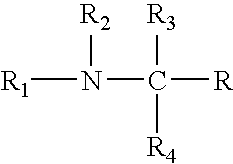Compositions and methods for enrichment of neural stem cells using ceramide analogs
a technology of neural stem cells and ceramide analogs, which is applied in the field of mammalian stem cells, can solve the problems of inability to tightly control the differentiation or form homogeneous populations of partially differentiated or terminally differentiated cells by pluripotent cell differentiation in vitro, and the mixed cell populations of this type of embryoid body are generally unlikely to be suitable for therapeutic or commercial use, and achieve the effect of enhancing the efficiency of transplantation
- Summary
- Abstract
- Description
- Claims
- Application Information
AI Technical Summary
Benefits of technology
Problems solved by technology
Method used
Image
Examples
example 1
Production of Ceramide Analogs
[0090] Ceramide analogs were produced as described in U.S. Pat. No. 6,410,597 to Bieberich, the entire contents of which are hereby incorporated by reference. Briefly, the compound S16 (N-(2-hydroxy-1-(hydroxymethyl)ethyl)-paimitoylamide) was synthesized from a solution of 50 mg (549 μmoles) of 2-amino-1,3-propanediol in 15 ml of pyridine supplemented with 1.65 mmol (457 μl) of palmitoylchloride at −30° C. The reaction mixture was stirred for 2 hours at room temperature followed by the addition of 30 ml of CH3OH. After stirring for another 2 hours at room temperature the reaction mixture was concentrated by evaporation. For selective hydrolysis of any ester groups formed during the reaction, the concentrate was treated with a 30 ml solution of CH3OH and sodium methoxide (pH 11-12) and stirred for 2 hours at room temperature. The reaction mixture was neutralized with dilute HCl and then concentrated. The reaction product obtained was purified by chroma...
example 2
Production of Essentially Serum Free MEDII Conditioned Medium, and Isolation of Small Molecular Weight Component of MEDII Media
[0094] Serum free MEDII (sfMEDII) was used as a source of the biologically active factor in all purification protocols. An essentially serum free MEDII conditioned medium was produced as follows. Hep G2 cells (Knowles et al., 1980 Nature, 288:615-618; ATCC HB-8065) were seeded at a density of 5×104 cells / cm2 and cultured for three days in DMEM. Cells were washed twice with 1×PBS and once with serum free medium (DMEM containing high glucose but without phenol red, supplemented with 1 mM L-glutamine, 0.1 mM β-ME, 1×ITSS supplement (Boehringer Mannheim), 10 mM HEPES, pH 7.4 and 110 mg / L sodium pyruvate) for 2 hours. Fresh serum free medium was added at a ratio of 0.23 ml / cm2 and the cells were cultured for a further 34 days. SfMEDII was collected, sterilized and stored.
Large Scale Preparation of R and E Fractions from sfMEDII
[0095] The starting material fo...
example 3
Induction of Apoptosis by Treatment of Murine ES Cells with Novel Ceramide Analogs of the β-Hydroxyalkylamine Type
Methods
In Vitro Neural Differentiation of Murine ES Cells
[0101] In vitro neural differentiation of mouse ES cells (ES-J1, ES-D3) followed a serum deprivation protocol as described previously (Hancock, et al., 2000 Biochem. Biophys. Res. Commun., 271: 418-421). The differentiation stages are outlined in FIG. 2. Briefly, ES cells were grown on gamma-irradiated feeder fibroblasts for four days in Knockout DMEM / 15% Knockout serum replacement, supplemented with ESGRO (LIF; Chemicon; Cat No. ESG1106) at a concentration of 103 units / ml medium. ES cells were then grown for another four days on gelatin-coated bacterial culture dishes without a fibroblast feeder layer, and were then grown for three days in Knockout DMEM / 15% heat-inactivated ES qualified Fetal Bovine Serum, supplemented with 103 units LIF per ml of medium. Upon trypsinization, ES cells were transferred to bac...
PUM
| Property | Measurement | Unit |
|---|---|---|
| temperature | aaaaa | aaaaa |
| pH | aaaaa | aaaaa |
| bed volume | aaaaa | aaaaa |
Abstract
Description
Claims
Application Information
 Login to View More
Login to View More - R&D
- Intellectual Property
- Life Sciences
- Materials
- Tech Scout
- Unparalleled Data Quality
- Higher Quality Content
- 60% Fewer Hallucinations
Browse by: Latest US Patents, China's latest patents, Technical Efficacy Thesaurus, Application Domain, Technology Topic, Popular Technical Reports.
© 2025 PatSnap. All rights reserved.Legal|Privacy policy|Modern Slavery Act Transparency Statement|Sitemap|About US| Contact US: help@patsnap.com



